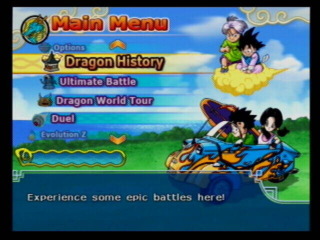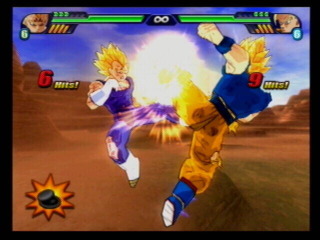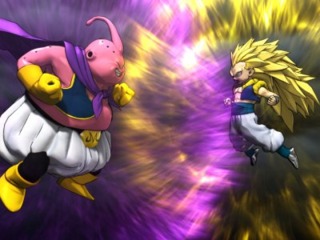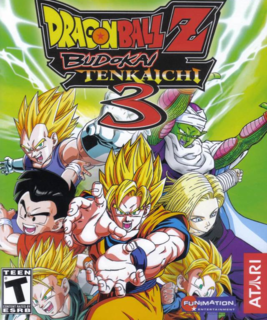There are many fighting games that have been critically acclaimed throughout the years, like the Street Fighter or Tekken series. But one bold gaming IP created its very own genre of 3d arena fighting: none other than Dragon Ball Z. DBZ took the fighting game scene to a whole new level that was never seen before. Starting with Budokai 1 through 3, it borrowed the style of Tekken and Virtua Fighter and expanded upon it by adding special attacks and energy blasts into the mix as well as the ability to fly through the air while battling in a 2.5d* space. After the budokai games came the next line of great DBZ games, this time in full 3d. This was the “Dragon Ball Z: Budokai Tenkaichi” series. The third game in that beloved collection has proven to be a favorite of mine and many others. The gameplay is thorough and exciting, and even though it has its flaws, the sheer amount of content this game has to offer will surely prove to turn any player into a die-hard fan. (Also be warned: this is a review of the Wii version.)
(*2.5d is when a game is in a 2d plane but is played in a 3d environment, like with Tekken, where fighters can roll toward or away from the screen.)
The story follows Goku and friends throughout the DBZ timeline, from the Saiyan Saga to the Buu Saga. More unlockable sagas would be Dragon Ball GT, the original Dragon Ball, and the original DBZ movies. Alongside the story mode are several other options: Dual, Ultimate Battle, Dragon World Tour, Dragon Net Battle, Evolution Z, and Ultimate training.

Even with all of these other ways to play, Dragon History (a.k.a. Story Mode) has a lot to offer, especially if you’re new to the Dragon Ball franchise. It covers all of the main points in each of the story arcs, also called sagas. Each of those points are a chapter in that saga, which are also given a narration about what’s been happening before the start of each match. Though these narration segments are nice to have, they only give the bare minimum without much context, expecting the player to already know most of the story. Once the game finally began, I quickly got into the swing of things. Being able to fly around and smash my opponents felt super exhilarating. All of the chapters that I played followed the story to a T, which was much appreciated. However, there is one thing about story mode that really got on my nerves: the cutscenes. The cutscenes for this game are done with the in-game character models, so the only thing characters could do when interacting with each other in these scenes was talk with their default expressions and move once in awhile. It also doesn’t help that only two characters can be onscreen at one time. It ruins the climactic moments when the only thing the characters can do is talk to each other from offscreen. Though, on a more positive note, you can “change” how each chapter ends. By defeating enemies before certain cutscenes or interactions, it’s possible to see what would have happened if that had occurred in the story. For instance, at the beginning of the Saiyan Saga, Goku sacrifices himself to kill Raditz. In the game, if Raditz is defeated before Goku has to sacrifice himself, then you’ll get to hear his reaction. The game expands upon this fact even more by including a bonus saga. After beating the campaign on any difficulty, the What-If Saga will appear. It includes battles that never happened in the DBZ cannon. This chapter is a huge favorite of mine and of many other fans too. It’s an awesome reward for all the hard work of beating the campaign.

On a slightly less positive note, I should probably mention the difficulty. The story includes easy, medium, and hard modes. Beating the campaign again with these other difficulties doesn’t unlock anything, which is a shame, but it does add some replayability to the campaign. Easy mode is pretty simple, as long as you understand the controls. Though I do recall that the first time I played, I got completely wiped out by the opponent, so don’t go in thinking that easy mode won’t be a challenge. That counts especially towards the later stages, so be sure to work your way up to medium and hard.
Next up is Ultimate Battle, which is split into three sections. The first is Sim Dragon. Sim Dragon is a kind of survival or simulation mode. Choose one fighter (at base form, if they have multiple) and train them to fight powerful enemies. There are ten days in between each battle, where you can either train, explore, sleep, or eat a senzu bean. The fighter starts out with 100% health and 0/15 in both attack and defense. By training, these can be increased at the expense of health. Options include offensive training, defensive training, or training to the limit, the latter taking the most health but giving the most stats. Besides that, you can also explore. Exploring causes random events to occur, which can help increase or decrease stats, gain money or items, or nothing at all. Last but not least is the option to sleep, which restores health but decreases stats slightly. Being able to effectively balance training, exploring, and sleeping is very challenging. After ten days have passed, the first fight begins. My battle with the first enemy went very well, since my stats were exponentially higher than what I normally end up with, about 10/15. After winning, the game gave me the option to either continue or stop there and save my score. If I choose to continue, then I risk losing the next fight, along with all of my points. Don’t forget to use the senzu bean when continuing, which fully restores health, but can’t be used again until it finishes recharging. Even though the amount of strategy this mode contains is debatable (with randomized encounters and stat boosts), I highly recommend it for more experienced players looking for a challenge.
Next is Mission 100, which puts the player up against a certain team of difficult enemies in 100 different scenarios. When choosing characters to fight with, it usually gives either a limit on the number of characters usable on a team, or it gives a limited number of points to choose characters with, each character’s cost depends on how powerful they are. These battles can be challenging and enjoyable, and even more can be unlocked by playing through Sim Dragon.

The third part to Ultimate Battle is survival mode, which is only accessible after completing all of the Mission 100 stages. Seeing as there are so many battles to complete to unlock it, I never had the chance to try it out. I’ll leave that up to all of you completionists out there. Have at it!
Up next is World Tour Mode, which allows you to participate in various tournaments. Just like in past DBZ games, these can be played either alone or with up to eight players. When playing alone, the tournament that’s currently open depends on what in-game time is displayed. There are five different ones to choose from, each containing a different battle style. Each is a fun inclusion to the game, and if you ever want to play a specific tournament that’s not open, than just go and play other modes and come back. One in-game hour passes after every battle, so the tournament you want to play in will eventually open, since they cycle every few hours. The multiplayer aspect alone that this mode offers is an easy way to get a group of friends together on the couch, at least for a good half hour.
Dual mode is, by far, the best part of this game. It allows battles with any characters that have been unlocked to fight each other, either player vs com, player vs player, or just watching the computer fight. This game contains over 150 characters, so battles that fans have been wishing for years are finally possible! Ever wanted to see what would happen if Broly fought Gogeta, or if Goku had to fight five of Frieza in a row? These are all possible, and I love it! Dual mode also shows how good the controls are! It’s very simple to understand, but also complex for those wanting to master them. Learning new moves by accident is also one of the many reasons that this mode is replayable time and time again. Timing a teleport at just the right time feels super satisfying. One thing I must bring up, though, is make sure you have enough space when playing this way. Sometimes the game won’t register certain movements, and it makes you a sitting duck instead. The hectic battles and tough challenges this mode contains, along with difficulty changeability and even the power to change the announcer, this is easily the highlight of the game. But, no matter how great a game like this is, there’s always one glaring flaw.
That flaw is the mode Dragon Net Battle, an online multiplayer mode that literally crashed my Wii within the first 15 minutes that I tried it. This mode is supposed to allow online matches against other players, which is great and all, but the frame rate slams to a halt as soon as the battle starts. After waiting about ten minutes for the characters on screen to unfreeze, I had to restart my console and reconnect. Needless to say, don’t even bother thinking about dusting this off.
Finally, we’ve arrived at Ultimate Training and Evolution Z. Ultimate training includes tutorial stages to learn how to play the game and master the many techniques. It also includes a training mode where moves and abilities can be put into action. Evolution Z is this game’s way to customize fighters. Here you can purchase and equip Z items, which are powerups that can increase stats and change a fighter’s style of play. Though I normally don’t dive too deep into this section of the game, I recommend giving it a shot. It helps make a character unique and fit better with anyone’s playstyle.
The feeling this game gives me when I battle is pure, unaltered exhilaration. I really love the battle system and mechanics, especially with the Wii remote and nunchuck controls. Using them pulled me more into the experience and felt very gratifying. I even had to take a breather after a few really tough brawls. I also really dig the sound effects and soundtrack. They seem straight from the show and really add to the experience. Even though this game has some glaring flaws, namely the old character model quality, the online battles, and the cutscenes, it’s still a blast to play. The huge amount of content this game offers is enough to make a fan out of anyone.

